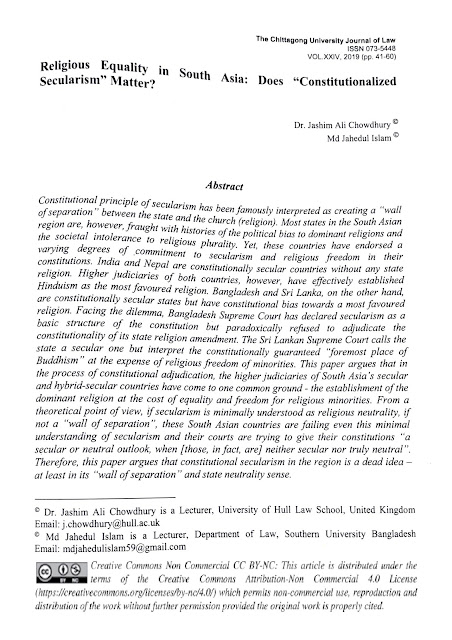Sunday, August 6, 2023
'তত্ত্বাবধায়ক সরকার' ব্যবস্থা: একটি সাংবিধানিক মূল্যায়ন ও বিকল্প সন্ধান
Thursday, August 3, 2023
Religious Equality in South Asia: Does “Constitutionalised Secularism” Matter?
Wednesday, August 2, 2023
Parliament of Bangladesh: Constitutional Position and Contributions
Parliament of Bangladesh: Constitutional Position and Contributions
Making and Unmaking the Constitution of Bangladesh
The Parliament (Jatya Sangsad) of Bangladesh
The Parliament (Jatya Sangsad) of Bangladesh
M Jashim Ali Chowdhury
Published in: Po Jen Yap and Rehan Abeyratne (eds) Routledge Handbook of Asian Parliaments, (Routledge 2023), pp 103-124
Link: https://doi.org/10.4324/9781003109402-9
Abstract
The Parliament of Bangladesh (hereinafter, the Parliament) is officially known as the Jatiya Sangsad (House of the Nation). It is a unicameral legislature established under Article 65 of the Constitution of the People's Republic of Bangladesh (hereinafter, the Constitution). Modelled on Westminster, the Parliament is entrusted with legislative powers, constitutional amendment power, financial and budgetary powers, and the powers of democratic oversight over the government. The Prime Minister and the Cabinet are drawn from the majority parliamentary party. The government remains in power so long as it bears the confidence of Parliament. As Bangladesh recognises constitutional supremacy, parliamentary laws and even constitutional amendments are subject to judicial review. The Supreme Court of Bangladesh is considered the guardian of the written Constitution and, hence, has the power of judicial review over executive and legislative actions. This chapter explains the structure, composition, powers, functions, and legislative process of the Parliament. The chapter also includes critical reflections on several of its institutional aspects.
The Failure of Bangladesh's Constitutional Design Dr M Jashim Ali Chowdhury Published in Ngoc Son Bui, Mara Malagodi and Christopher Rob...

-
Fifty Years of Bangladesh Parliament A Critical Evaluation Dr M Jashim Ali Chowdhury Brill Asian Law Series Volume 14 Brill Nijhoff (2025) D...
-
Ethical Dilemmas of Corporate Lawyering: Lessons from the UK Solicitors Regulatory Authority (SRA) Standards and Regulations M Jas...
-
নতুন সংবিধান বিতর্ক: সাংবিধানিক ধারাবাহিকতা ও স্থায়িত্বের প্রশ্ন ড এম জসিম আলী চৌধুরী প্রভাষক আইন বিভাগ, ইউনিভার্সিটি অব হাল, যুক্তরাজ্য সিফ...
.jpg)
.jpg)
_page-0001.jpg)


.png)
.png)

.png)

.png)

